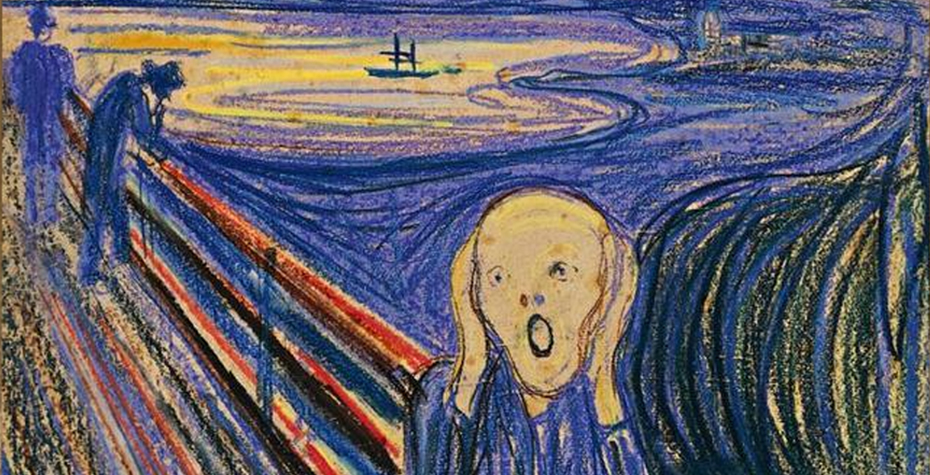Munch as Meme: Wellesley Professor on the Cultural Value of the $120M “Scream”

“The most immediate element, and the one that grabs us, is the boneless figure with the skull-like face, a human reduced to a basic, almost devolved life form. But the figure alone does not capture the raw power of the painting: The colors are intense and dissonant, causing optical excitation. That bridge to the left LOOKS like it should be a logical structure, stretching into the background, whereas it telescopes and throws the foreground figure into our own space. The body resonates with the sky, the water, the hills, so that there seems to be no barrier between the body and the environment. And of course the foreground figure is made all the more horrifying because of the two background figures that seem oblivious of the dissolving figure in the foreground. It is controlled, skillful, and open-ended in its story, making it therefore available to all of us to project ourselves into it." —Patricia G. Berman, Theodora L. and Stanley H. Feldberg Professor of Art, Wellesley College
Art enthusiasts around the world waited anxiously to hear the final selling price of Edvard Munch’s The Scream. The artwork, which was auctioned at Sotheby's on Wednesday, May 2, sold for a record $119,922,500 million to a still unnamed buyer, making it one of the most expensive works sold at auction in history. But one Wellesley College professor has long examined what may be the most significant value of the work—the image’s lasting cultural impact on society.
The Scream Meme
“Munch's Scream is without question one of the most recognizable and reproduced work of art worldwide. It’s also one of the most accessible and yet elusive paintings ever made,” said Patricia Berman, Theodora L. and Stanley H. Feldberg Professor of Art. “It has become a meme precisely because it seems to speak so directly of psychological extremis. This particular version, sold at Sotheby’s, is extraordinary because it also combines Munch’s prose poem (his commentary on the image), in his own hand, on the frame. It therefore offers a double artistic testimony to a state of mind.”
In addition to her role at Wellesley, Berman is a professor at the University of Oslo and one of the co-conveners of a new Edvard Munch Research Institute in Oslo, a consortium of the University of Oslo, the Munch Museum, and the Norwegian National Gallery. She has curated several major exhibitions of Munch’s work, including “In Munch's Laboratory: The Path to the Aula" (2011, Munch Museum, Oslo) and was the consultant to “Edvard Munch and the Modern Life of the Soul” (2006, Museum of Modern Art, NY). She is the author of Munch and Women: Image and Myth (1997, Art Services Intl).
According to Berman, The Scream, which has been an icon since the post-War years when it became associated with Existential philosophy, continues to remain alive to us generation after generation because its meaning shifts with contemporary values and conditions. “It is a work that has shaped our very images of the world around us and has become a form of cultural shorthand,” she said.
“Whether you read the painting as a personal testimony, a political commentary, or a response to the speed and complexity of modern life, it has instant relevance,” Berman said, which she considers to be a “brilliantly strategic” move on Munch’s part. Her students seem to agree.
Jenny Harris ’12, who is currently one of Professor Berman's honors thesis students, recalls studying the painting with Berman in her Art History 101 class. “It was one of the first times I thought about how visual images become pervasive in mainstream culture,” Harris said. “Munch took a straightforward, recognizable gesture, and turned it into a sensational symbol of modern anxiety, one which continues to have widespread lasting resonance.”
While much has been said of the artist's expression of turmoil and angst, Berman sees Munch as singular in both his mining of his memories and perceptions, and at the same time his mastery over image making. In The Scream, Munch invented a new language, one that translates intimate, interior sensation into a public communication.
The astronomical sales price of the work certainly commands attention, but it is the composition itself that captures our individual and collective imagination and seems familiar, intimate, and evocative.
Berman told the AP, “It is extraordinary that The Scream has now set the world's record for a painting sold at auction. Clearly, this is the brass ring for any collection. I continue to have my fingers crossed that it will be part of a public collection so that it will enrich the lives of the broadest possible public."
Professor Berman’s research interests include turn-of-the-20th century European art, especially in Scandinavia, and mid-century modern American painting and photography. She is interested in national identity formation, issues of gender and sexuality, and in the problems of public space. In addition to Edvard Munch, her books include studies of the artists James Ensor and of Danish painting in the 19th century.
Several works by Edvard Munch are on display for public viewing at the Davis Museum at Wellesley College.
